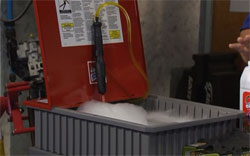Parts Cleaning
No matter what you do on an automobile, you want the parts that you’re working with to be clean. And that means you need some way to clean those parts yourself. Well, every shop in the world has a professional parts cleaner, but that’s not exactly what you want at home.
Now, before we go into that, let’s talk a little bit about what we’re trying to avoid here. If we take a car apart…it doesn’t make any difference what it is…if we put it back together with grease and dirt all over it, and as we handle it, we migrate that dirt into bearings and things like that, we’re going to fix one thing and cause the failure of something else. So everything on it should be clean. Now, one of the things you don’t want to do is you don’t want to try to clean various electronic components, you don’t want to clean things like the brushes inside this alternator and things like that because you could actually damage them. But most parts…well, you can clean it and you can do it at home.
 Now, here we have an oil eater system. It uses a…well, it’s a chemical that is very similar to a detergent that you would use at home. It’s safe to use, easy to handle and does a good job of cleaning. We’ve also had good luck with Eastwood’s Metal Wash, which has a rust inhibitor in it. So, some of the tin parts and things that you clean...this will keep them from rusting. Now, along with that, some precautions. Here we have rubber gloves that we want to wear in order to protect chemicals from being absorbed through the skin of our hands. We want to wear some kind of eye protection because a lot of these chemicals, if you get them in your eye, you’re going to be hating life, I’ll tell you that. Alright, you’ll need an assortment of brushes. There are different types, from round ones, such as we have here that are very stiff and they get into close corners. You have long ones that will do cracks and crevices. And here we have one that a lot of people overlook. This is a brass brush and it’s used to get rid of the really heavy accumulations of caked-on dirt and grease.
Now, here we have an oil eater system. It uses a…well, it’s a chemical that is very similar to a detergent that you would use at home. It’s safe to use, easy to handle and does a good job of cleaning. We’ve also had good luck with Eastwood’s Metal Wash, which has a rust inhibitor in it. So, some of the tin parts and things that you clean...this will keep them from rusting. Now, along with that, some precautions. Here we have rubber gloves that we want to wear in order to protect chemicals from being absorbed through the skin of our hands. We want to wear some kind of eye protection because a lot of these chemicals, if you get them in your eye, you’re going to be hating life, I’ll tell you that. Alright, you’ll need an assortment of brushes. There are different types, from round ones, such as we have here that are very stiff and they get into close corners. You have long ones that will do cracks and crevices. And here we have one that a lot of people overlook. This is a brass brush and it’s used to get rid of the really heavy accumulations of caked-on dirt and grease.
Now, here’s something you have to be aware of. When you put these chemicals into a machine like this oil eater, it is environmentally safe, but once you have cleaned the various parts and so on, and now the liquid is full of grease and grime and all sorts of things like that, it now, in most cases, is going to be a hazardous material. You do not want to pollute the environment. So that means you don’t throw it down the sewer, you don’t flush it down the toilet, you don’t do anything like that with it. You contact your local agency that handles waste materials and you find out from them what the proper method is to dispose of the used chemicals.
And if you have a question or comment, drop me a line right here at MotorWeek.





